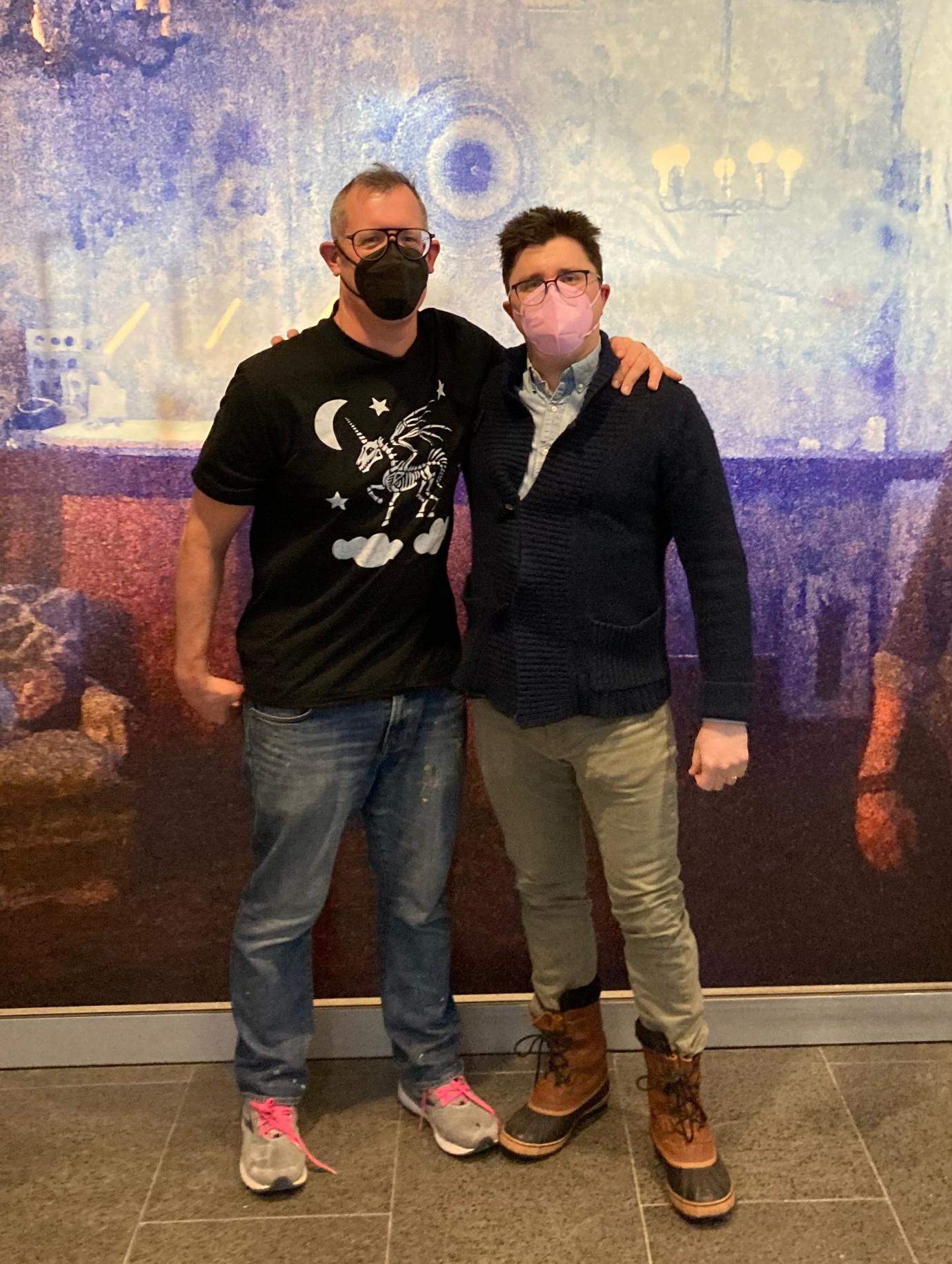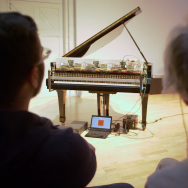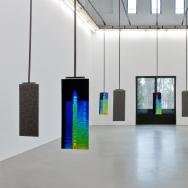In 2016, artists Amber Ginsburg and Sara Black harvested a tanoak tree on the California coast that was dying from sudden oak death, a disease caused by an accidentally introduced pathogen. After drying the tree in a high-temperature kiln to remove any trace of the pathogen, they gave it new life by turning it into 7,000 handmade pencils: works of art that could be used to produce more art.

Those pencils are now part of “On Drawing Drawing On,” a new exhibition at the University of Chicago’s Gray Center for Arts and Inquiry. Running through March 13 in the Logan Center Gallery, the exhibition celebrates the 10th anniversary of the Gray Center’s signature initiative: the Mellon Collaborative Fellowship in Arts Practice and Scholarship.
“The show is a riff on the double meaning of drawing,” said Seth Brodsky, director of the Gray Center. “It obviously designates the act of creating art with pencil and paper. But it also involves pulling, dragging, drawing out, selecting too. It speaks to the way Gray Center fellows select each other, draw from and on each other, find things in each other’s work neither knew was there in the first place.”
Brodsky continued: “What’s nice is how the two meanings converge here pretty directly. These fellowships are all, in one way or another, sketchy, freehand, drawing out a search for larger forms not available in advance. Also a kind of well-work, hauling up various unknowns from the dark.”
Displaying a variety of sketches, cartoons, sculptures and other media, the exhibition echoes the mission of the Gray Center’s Mellon fellowships, which bring together scholars and artists for multidisciplinary exploration. The show includes contributions from some of the most renowned creative minds on the UChicago faculty—including Theaster Gates, Pope.L, Jessica Stockholder and Augusta Read Thomas—as well as a slew of award-winning artists who have been drawn to the Gray Center’s spirit of collaboration over the past decade.
“The show is a riff on the double meaning of drawing.”
These projects can become an unexpected bridge between different disciplines. What happens, for example, when an illustrator works with doctors on a project examining the consequences of difference and distrust between patients and caregivers?
UChicago physicians Monica Peek and Elizabeth Tung explore those overlaps in “Common Place,” a series of patient portraits they developed with artist Julia Kuo. Accompanied by interviews, the images investigate structural racism through the lens of COVID-19.
“I have always been interested in narrative storytelling as a way of sharing patients’ lived experiences,” said Peek, a professor of medicine who focuses on reducing health care disparities. “This collaboration allowed me to see how the visual arts and narrative storytelling together are a much more compelling and powerful venue for doing this work.”
In their project, Kuo, Peek and Tung investigated the challenges faced by Black mothers. Their contribution to the exhibition is a portrait of Candace Mason, who delivered her son in Chicago during the first wave of COVID-19 and was the first interviewee for the project. Coincidentally, Tung herself gave birth to her own child around the same time.
“Candace and I had similar experiences on the one hand, but completely different experiences on the other,” said Tung, an assistant professor of medicine who studies chronic disease management through the lens of race, place and poverty. “I think that dissonance—between feeling like we shared a ‘common place’ or experience together, but also lived in a very uncommon space and reality, is something that stuck with me throughout the project.”
Mason’s experience, Tung and Peek wrote, highlighted the tradeoffs Black women are sometimes forced to make during pregnancy. For example, Mason worked with a doula but, due to her hospital’s COVID-19 policy, could only choose one person to accompany her during delivery. Thus, Mason had to choose between her doula, her mother or her partner—between advocating for health equity, and the comforting presence of a loved one.
“I have always been interested in narrative storytelling as a way of sharing patients’ lived experiences.”
Many of the works also nod toward future possibilities. Ginsburg and Black, MFA’06, are working with University of Illinois political scientist Samantha Frost on a new project: “Untidy Objects,” a living sculpture featuring thousands of plant seedlings. The project will make use of the pencils that comprise “7000 Marks,” deploying them in public workshops that seek to explore human dependence on the environment and other people.
The opportunity to work with Black and Frost has sparked new ways of thinking for Ginsburg, a lecturer in UChicago’s Department of Visual Arts.
“We tend to develop these neural pathways, and that becomes how we see the world,” she said. “For example, Sara and I tend to articulate language through material. But there’s a lovely way that Sam brings attention to language that has given me a better chance of actually changing my mind, learning and growing.”
“On Drawing Drawing On” also offers windows into the creative process. Thomas, a celebrated composer, shared a process drawing for her work “Far Past War,” which will be performed for the first time on March 13 at the Washington National Cathedral. On display from Gates, renowned internationally for his use of art in urban planning and social practice, is a “mind map” for an essay he wrote about artist Tony Lewis.

Also included in the exhibition are an annotated book, photographs documenting the constructing of an anti-gun violence sculpture, a mural of a videogame map, a chalkboard that extends from the wall onto the floor—inviting visitors to add their own illustrations, and more. The many contributors include cartoonist Alison Bechdel, a former MacArthur fellow who is perhaps best known for her graphic memoir Fun Home; artist Lawrence Abu Hamdan, who shared the prestigious Turner Prize in 2019; and Assoc. Prof. Catherine Sullivan, who has created and exhibited film, theater, and installation work around the world.
The Gray Center’s Mike Schuh, co-curator of the exhibition, recalled the 2011 investigation of the physics and aesthetics of light by architect James Carpenter and UChicago physicist Sidney Nagel—who were among the program’s first fellows—as one that set the tone for the kinds of inspired collaborations that the program has fostered in the intervening years.
By teaching a course on lighting together and taking a trip to Greenland to study winter light in the Arctic, Schuh said, the two were able to “really think about what it means to come together … as a part of the fellowship experience.”
“It’s like dreaming together, in a way,” Schuh said. “Being in each other’s lives—and in each other’s way—and seeing what comes of that.”
Carpenter designed the lights that illuminate the Midway Plaisance at night, and his mockups and sketches for them are included in the exhibition. Nagel, the Stein-Freiler Distinguished Service Professor of Physics, submitted a new poem about aesthetics and scientific inquiry.
“What really surprised me was how open and playful everybody was.”
“What really surprised me was how open and playful everybody was,” said Zachary Cahill of the Gray Center, who co-curated of the exhibition with Schuh. “If the Gray Center is doing something right, it’s allowing people to experiment in a way that frees them from having to worry about their professional identity in the context of traditional academic protocols: Sid Nagel submitted a poem—I love that.”
The exhibition is open in the Logan Center’s first floor gallery until March 13. Its many-layered title, however, also hints at an upshot: the prospect of more collaborations in the years to come.
“In a way, the show itself is a kind of ‘sketch’ for thinking about where we will go in the next 10 years,” Cahill said. “One of the powers of the center is that it functions as a space—not just for literally sketching—but for sketching out ideas. Seeing how that has played out over the past 10 years has reaffirmed our method as we look to the future.”















